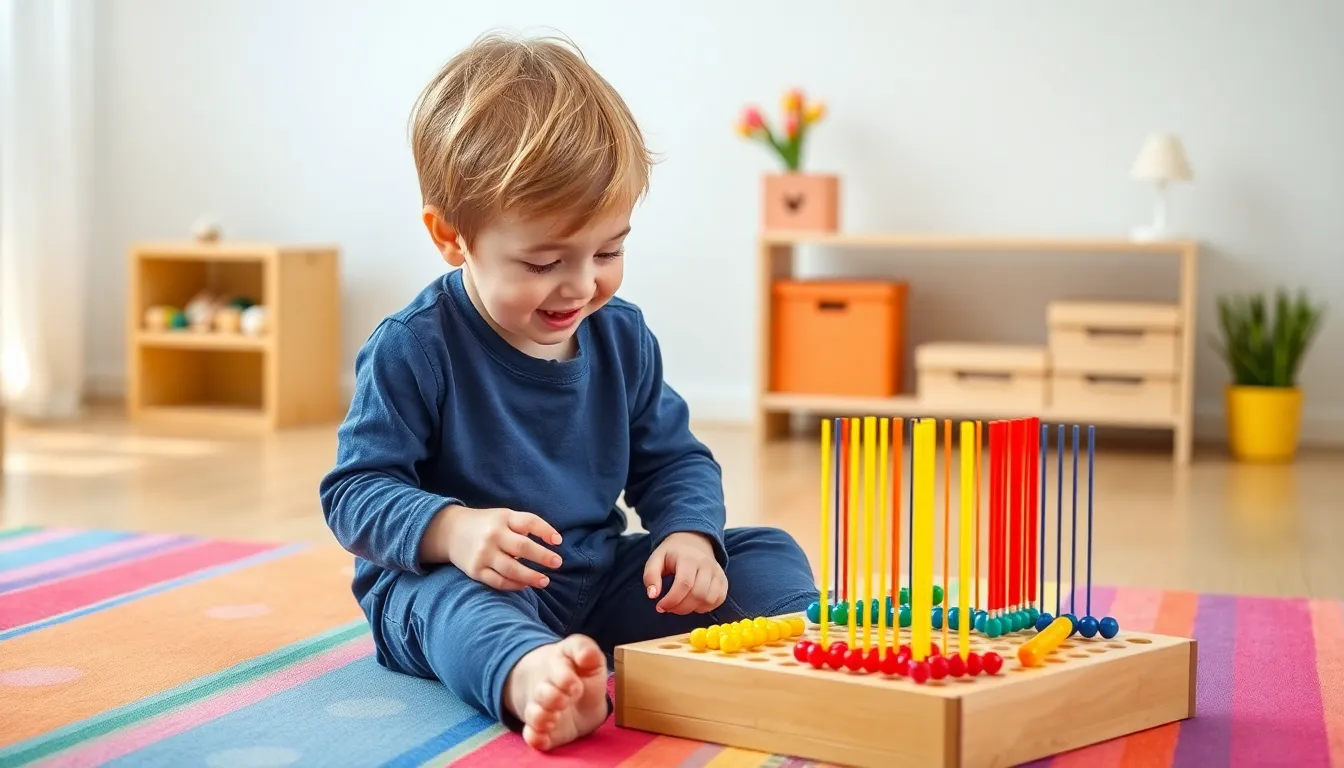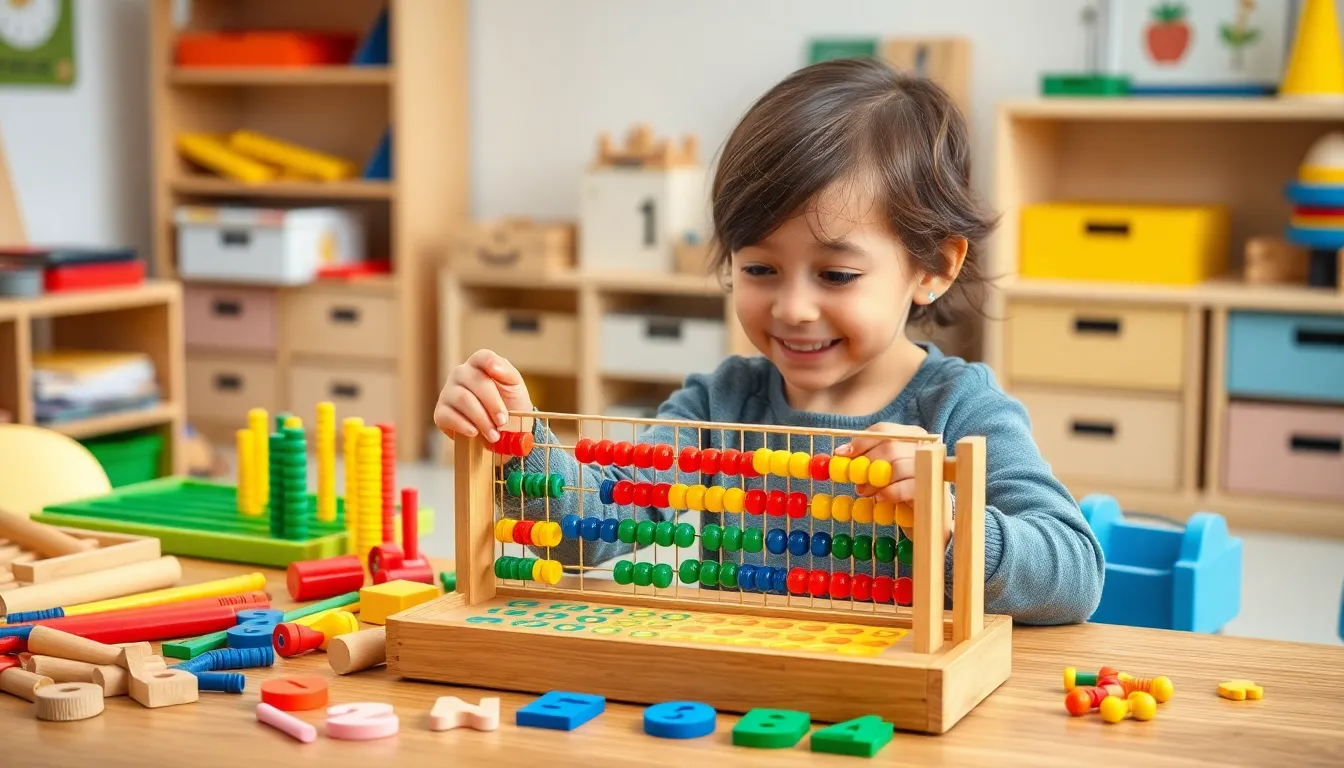Imagine a world where math isn’t just numbers on a page but a playful adventure filled with colorful materials that spark curiosity. That’s the magic of Montessori math materials. Designed to engage young minds, these hands-on tools transform abstract concepts into tangible experiences. They make learning math feel less like a chore and more like a treasure hunt.
Table of Contents
ToggleOverview of Montessori Math Materials
Montessori math materials play a crucial role in early childhood education. Designed to facilitate hands-on learning, these tools encourage exploration and discovery. Each material serves a specific purpose, guiding children through various mathematical concepts.
The Number Rods provide a visual and tactile introduction to numbers and counting. Children stack the rods from shortest to longest, internalizing the concept of quantity. Sandpaper Numbers allow young learners to trace numbers while reinforcing their recognition and pronunciation.
Bead Frames offer an opportunity to understand addition and subtraction through concrete representation. As they manipulate the beads, children experience mathematical operations in a more intuitive way. Golden Beads enhance their understanding of place value, providing a clear experience of units, tens, hundreds, and thousands.
Fraction Circles engage students in understanding parts of a whole. They can explore equivalent fractions by manipulating colorful pieces, making learning visually stimulating. In contrast, Geometry Solids help children comprehend three-dimensional shapes by allowing them to analyze and compare different forms.
Addition and Subtraction tables simplify the process of understanding operations. Children practice their skills through engaging visual aids, making abstract concepts more approachable. Math Cards promote fact memorization while encouraging a fun and relaxed atmosphere during learning.
Utilizing these materials cultivates a deeper understanding of mathematical principles. By engaging with diverse tools, children develop a lasting confidence in their mathematical abilities. Each material transforms the learning experience into a playful journey, enhancing both comprehension and retention.
Key Features of Montessori Math Materials

Montessori math materials exhibit several key features that enhance mathematical understanding through interactive play.
Hands-On Learning
Hands-on learning characterizes Montessori math materials. Each tool promotes active engagement, allowing children to physically manipulate objects. For instance, children explore number concepts using Number Rods, which offer a visual and tactile way to understand quantities. Bead Frames facilitate addition and subtraction through direct interaction, making abstract numbers tangible. Engaging with these materials fosters a deeper understanding of mathematical principles while encouraging independence and self-directed exploration. Children often develop critical thinking skills as they experiment and solve problems hands-on. Ultimately, hands-on learning transforms math from a theoretical concept into a concrete experience.
Sensory Engagement
Sensory engagement plays a crucial role in Montessori math materials. Colorful and varied textures attract children’s attention, stimulating their senses and encouraging exploration. Sandpaper Numbers, for example, allow kids to feel the shapes of numbers as they learn about them. Fraction Circles invite learners to visually and physically manipulate pieces, deepening their understanding of parts and wholes. Geometry Solids provide opportunities to explore three-dimensional shapes through touch and observation, enhancing spatial awareness. Each encounter helps solidify abstract mathematical concepts in children’s minds, making learning both enjoyable and effective. Sensory engagement ultimately supports retention through memorable learning experiences.
Different Types of Montessori Math Materials
Montessori math materials come in various forms, each designed to enhance specific mathematical skills. These educational tools support young learners in developing a solid foundation in mathematics.
Counting and Number Recognition Tools
Number Rods provide a visual and tactile way to introduce counting and numbers. Children manipulate these rods to reinforce their understanding of quantity and sequencing. Sandpaper Numbers promote number recognition through touch, helping learners feel the shapes of digits. Using these materials, children can enjoy learning at their own pace, making connections between abstract concepts and physical representations.
Operations and Calculations Materials
Bead Frames serve as an effective tool for teaching addition and subtraction through hands-on manipulation. Children can physically move beads to visualize calculations, which supports comprehension. Golden Beads enhance the understanding of place value. By using these beads, learners experience how numbers combine or split apart in various operations. Math Cards provide an engaging way to reinforce basic math facts, encouraging memorization in a fun environment.
Geometry and Spatial Awareness Tools
Fraction Circles introduce the concept of parts of a whole through interactive play. Children explore fractions visually and physically, building a foundation for more complex math later on. Geometry Solids allow young learners to investigate three-dimensional shapes, helping them recognize and differentiate spatial forms. By engaging with these materials, students cultivate an appreciation for geometry and develop spatial awareness through hands-on experience.
Benefits of Using Montessori Math Materials
Montessori math materials offer numerous benefits in early childhood education. These tools not only enhance engagement but also foster a deeper understanding of mathematical concepts.
Promotes Independence
Montessori math materials encourage children to learn at their own pace. By manipulating objects like Number Rods and Bead Frames, students gain confidence in their abilities. Independence arises as they explore these tools without constant guidance, allowing them to troubleshoot and discover solutions. This self-directed approach cultivates a sense of ownership over their learning experiences, enhancing motivation and self-esteem. Children often become more persistent when faced with challenges, reinforcing critical thinking and adaptability.
Enhances Problem-Solving Skills
Montessori math materials significantly boost problem-solving skills. Engaging in activities with tools like Fraction Circles and Geometry Solids fosters analytical thinking. Learners frequently confront mathematical challenges, prompting them to devise strategies independently. Each hands-on experience encourages them to find multiple ways to reach a solution. This exploration promotes creative problem-solving, making mathematics feel less intimidating. The ability to visualize problems using tangible materials deepens comprehension, enabling stronger retention of concepts and principles. As children engage with these resources, their critical thinking and decision-making skills flourish.
Montessori math materials play a vital role in shaping children’s mathematical understanding. By transforming abstract concepts into tangible experiences, these tools foster a love for learning. Engaging with colorful and interactive materials not only enhances comprehension but also builds confidence in young learners.
As children explore and manipulate these resources, they develop essential skills like critical thinking and problem-solving. This hands-on approach encourages independence and allows students to progress at their own pace. Ultimately, Montessori math materials create a positive learning environment that inspires curiosity and a lifelong appreciation for mathematics.




